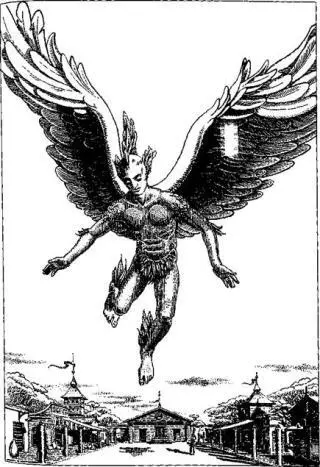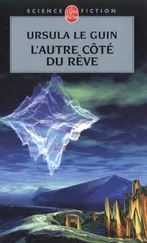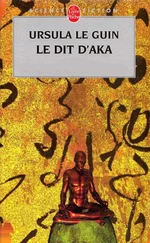Moulting is a continuous process, not seasonal. As people age, not all the moulted feathers grow back, and patchy baldness is common among both men and women over forty. Most people, therefore, save the best of their head feathers as they moult out, to make into wigs or false crests as needed. Those whose plumage is scanty or dull can also buy feather wigs at special shops. There are fads for bleaching one’s feathers or spraying them gold or curling them, and wig shops in the cities will bleach, dye, spray, or crimp one’s plumage and sell headdresses in whatever the current fashion is. Poor women with specially long, splendid head feathers often sell them to the wig shops for a fairly good price.
The Gyr write with quill pens. It is traditional for a father to give a set of his own stiff ruff quills to a child beginning to learn to write. Lovers exchange feathers with which they write love letters to one another, a pretty custom, referred to in a famous scene in the play The Misunderstanding by Inuinui:
O my betraying plume, that wrote his love
To her! His love—my feather, and my blood!
The Gyr are a staid, steady, traditional people, uninterested in innovation, shy of strangers. They are resistant to technological invention and novelty; attempts to sell them ballpoint pens or airplanes, or to induce them to enter the wonderful world of electronics, have failed. They continue writing letters to one another with quill pens, calculating with their heads, walking afoot or riding in carriages pulled by large, doglike animals called ugnunu, learning a few words in foreign languages when absolutely necessary, and watching classic stage plays written in traditional meters. No amount of exposure to the useful technologies, the marvelous gadgets, the advanced scientific knowledge of other planes—for Gy is a fairly popular tourist stop— seems to rouse envy or greed or a sense of inferiority in the Gyran bosom. They go on doing exactly as they have always done, not stodgily, exactly, but with a kind of dullness, a polite indifference and impenetrability, behind which may lie supreme self-satisfaction, or something quite different.
The crasser kind of tourists from other planes refer to the Gyr, of course, as birdies, birdbrains, featherheads, and so on. Many visitors from livelier planes visit the small, placid cities, take rides out into the country in ugnunu chaises, attend sedate but charming balls (for the Gyr like to dance), and enjoy an old-fashioned evening at the theater, without losing one degree of their contempt for the natives. “Feathers but no wings” is the conventional judgment that sums it up.
Such patronising visitors may spend a week in Gy without ever seeing a winged native or learning that what they took for a bird or a jet was a woman on her way across the sky.
The Gyr don’t talk about their winged people unless asked. They don’t conceal them or lie about them, but they don’t volunteer information. I had to ask questions fairly persistently to be able to write the following description.
Wings never develop before late adolescence. There is no sign at all of the propensity until suddenly a girl of eighteen, a boy of nineteen, wakes up with a slight fever and an ache in the shoulder blades.
After that comes a year or more of great physical stress and pain, during which the subject must be kept quiet, warm, and well-fed. Nothing gives comfort but food—the nascent fliers are terribly hungry most of the time—and being wrapped or swaddled in blankets, while the body restructures, remakes, rebuilds itself. The bones lighten and become porous, the whole upper body musculature changes, and bony protuberances, developing rapidly from the shoulder blades, grow out into immense alar processes. The final stage is the growth of the wing feathers, which is not painful. The primaries are, as feathers go, massive, and may be a meter long. The wingspread of an adult male Gyr is about four meters, that of a woman usually about a half meter less. Stiff feathers sprout from the calves and ankles, to be spread wide in flight.
Any attempt to interfere, to prevent or halt the growth of wings, is useless and harmful or fatal. If the wings are not allowed to develop, the bones and muscles begin to twist and shrivel, causing unendurable, unceasing pain. Amputation of the wings or the flight feathers, at any stage, results in a slow, agonising death.
Among some of the most conservative, archaic peoples of the Gyr, the tribal societies living along the icy coasts of the north polar regions and the herdsfolk of the cold, barren steppes of the far south, this vulnerability of the winged people is incorporated into religion and ritual behavior. In the north, as soon as a youth shows the fatal signs, he or she is captured and handed over to the tribal elders. With rituals similar to their funeral rites, they fasten heavy stones to the victim’s hands and feet, then go in procession to a cliff high above the sea and push the victim over, shouting, “Fly! Fly for us!”

Among the steppe tribes, the wings are allowed to develop completely, and the youth is carefully, worshipfully attended all that year. Let us say that it is a girl who has shown the fatal symptoms. In her feverish trances she functions as a shaman and soothsayer. The priests listen and interpret all her sayings to the people. When her wings are full grown, they are bound down to her back. Then the whole tribe set out to walk with her to the nearest high place, cliff or crag—often a journey of weeks in that flat, desolate country.
On the heights, after days of dancing and imbibing hallucinatory smoke from smudge fires of byubyu wood, the priests go with the young woman, all of them drugged, dancing and singing, to the edge of the cliff. There her wings are freed. She lifts them for the first time, and then like a young falcon leaving the nest, leaps stumbling off the cliff into the air, wildly beating those huge, untried wings. Whether she flies or falls, all the men of the tribe, screaming with excitement, shoot at her with bow and arrow or throw their razor-pointed hunting spears. She falls, pierced by dozens of spears and arrows. The women scramble down the cliff, and if there is any life left in her, they beat it out with stones. They then throw and heap stones over the body till it is buried under a cairn.
There are many cairns at the foot of every steep hill or crag in all the steppe country. Ancient cairns furnish stones for the new ones.
Such young people may try to escape their fate by running away from their people, but the weakness and fever that attend the development of wings cripple them, and they never get far.
There is a folktale in the South Marches of Merm of a winged man who leapt up into the air from the sacrificial crag and flew so strongly that he escaped the spears and arrows and disappeared into the sky. The original story ends there. The playwright Norwer used it as the basis of a omantic tragedy. In his play Transgression, the young man has appointed a tryst with his beloved and flies there to meet with her; but she has unwittingly betrayed him to another suitor, who lies in wait. As the lovers embrace, the suitor hurls his spear and kills the winged one. The maiden pulls out her own knife and kills the murderer and then—after exchanging anguished farewells with the not quite expired winged one—stabs herself. It is melodramatic but, if well staged, very moving; everybody has tears in their eyes when the hero first descends like an eagle, and when, dying, he enfolds his beloved in his great bronze wings.
A version of Transgression was performed a few years ago on my plane, in Chicago, at the Actual Reality Theater. It was probably inevitably, but unfortunately, translated as Sacrifice of the Angels. There is absolutely no mythology or lore concerning anything like our angels among the Gyr. Sentimental pictures of sweet little cherubs with baby wings, hovering guardian spirits, or grander images of divine messengers would strike them as a hideous mockery of something every parent and every adolescent dreads: a rare but fearful deformity, a curse, a death sentence.
Читать дальше










